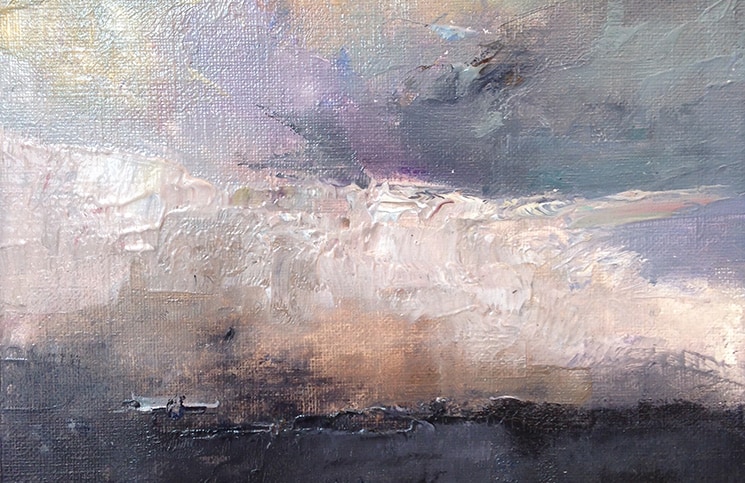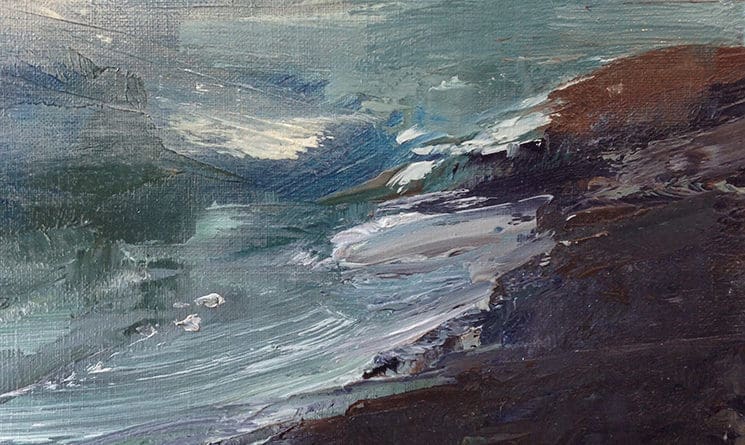Christopher Volpe might change how you feel about local landscape paintings. The difference is in really feeling something.
His paintings often start outside, en plein air, but he lets emotion and intuition finish them. Largely self-taught, Volpe quickly established himself as an artist with uncommon vision and a truly evocative style. Not only is his work now available at several galleries, from Ogunquit, Maine, to Naples, Fla., but he’s also teaching weekly art classes, at the Button Factory in Portsmouth, and at his studio in Lowell, Mass.
A selection of his recent work is on view through August in “Seacoast Squared” at the Kennedy Gallery in Portsmouth. The Sound caught up with Volpe this week to learn how he taught himself and others to see, and feel, like an artist.
How did the student become the teacher at such an inspiring pace?
Wow, this is a question I wonder about all the time! I think the answer has to do with the backwards path I took to becoming a painter. … My plan was to be an actively publishing poet and teacher in a college or university. I was basically a creative artist and a teacher before I started painting, which was only eight years ago, at the age of 41. So it seemed natural and inevitable that teaching would remain central to my life and work.
The way I fell into painting demystified it and made me realize it’s not so much about talent, something either you have or you don’t. It’s a matter of coordinating mind, imagination, and hand. Part of my teaching philosophy is that anyone with proper motivation can do this, because I’m living proof. I love the idea that you can learn all there is to know about the basic techniques of oil painting in a matter of months, and then it takes a lifetime to learn how to make it your own.
I’m convinced artistic expression can be taught because I began painting almost as a fluke, without any training. This was a few years after I started teaching the history of art, which I only started doing as a favor to the dean of Portsmouth’s Franklin Pierce University campus, where I was teaching lit classes at night. Painting wasn’t my area of expertise, so I had no fear because the stakes were so low.
I had years of background and teaching in poetry, art, aesthetics, mythology, literature, and the psychology of creativity, even improvisation in music. In a certain sense, much the same spirit moves through all of these things, and it’s that spirit I want to get in touch with and to teach others to value and find their own access to.
More than anything else, I think that freedom, that total permission I gave myself, led to my ability to paint, and that’s also what drives my teaching. I figure, if I can do it, someone with zero academic fine-art training, then other people can too. I try to teach people by example how to get over the hurdle of fear, to cultivate their own sensitivities, to allow personal inspiration to direct their art.

Above, Lifting. At top, Tidal Light (Marginal Way). Both by Christopher Volpe, on display at the Kennedy Gallery in Portsmouth as part of the Seacoast Squared exhibit.
You teach technical skills and historical examples, but also value intuition and emotion. How do you use both knowledge and feeling?
In a way, maybe knowledge provides the context in which feeling can operate on its own. I’ll have a starting place based on knowledge of what’s been done, what might work, what I want to try, and then I’ll get lost in the improvisational aspect, sort of carried along on feeling. Maybe it’s times when those things flow together in some kind of balance that the best work gets done.
It’s critical for any artist to cultivate both. Most beginners worry too much about the critical, technique side of things and not enough about what they want to express. Technique is only there to support the artist’s vision, and if the vision is primary and it’s strong and sincere enough, the artist will end up inventing his or her own technique anyway.
And some people worry about being corrupted by influences or something, but nothing gets created in a vacuum, not the uninformed art of the present or the great masterpieces of the past or even the visionary and highly original art of someone like Albert Ryder or Forrest Bess. I think the trick is to internalize what you love of what’s been done and cultivate your ability to do something equally as meaningful and as daring. The more you know, the better equipped you are to take the best things and apply them to something new. Maybe, ultimately, it’s like abstract artist Ron Gorchov says: You have to try to make your work be the next consequential step, to build on what you’re seeing that you love and try to bring it to unknown terrain.
Why do you look to nature and the outdoors to express individuality and innermost feelings
It’s natural for me to do that because that’s how poets think. Landscape painting is similar to poetry in that both use the imagery of nature as metaphors for human experience. The painting is a vehicle, not an end in itself. So the point of painting a picture of the ocean becomes not to create an accurate rendering of the thing – we have cameras for that – nor is it, or should it be, merely a formal exercise in composition, or even capturing the essence of a place. I think great landscape painting has little or nothing to do with place.
Painting, to me, has everything to do with locating feelings and deeply felt, intuitive ideas through the materiality of paint, through light and color, texture, stroke, and line. I flirt with non-representational painting all the time, but so far I’ve found I need the reference to the shared visible world as “demonstration and proof,” as Birge Harrison said, of the reality and validity of the feelings and ideas at the painting’s core. Maybe I’ll find a way to let go entirely of reference and still feel like I am communicating something authentic and heartfelt, but it hasn’t happened for me yet.
Are you leaning more toward abstract or representational painting, or are you always seeking a balance?
I used to torture myself over that question, but more and more I think these terms are becoming less useful. Because I came to painting in my late, backward kind of way, I had the sense of having something to say before I had the technique to say it. And every day I still wake up feeling that I’m still desperately trying to catch up with that. And the only way to get there is to do it. You have to think with a brush full of paint in your hand or it’s useless. Most artists learn formal technique first and then go off to find their particular path. I knew loosely where I wanted to end up as a painter when I started, so I’ve had to go back and fill in my knowledge and technique as I go.
…painting plein air you can’t help but absorb a certain vocabulary of place that serves you imaginatively in the studio…
Do you still paint images that come from dreams or memories as well as painting en plein air? Has one technique become more important to you?
I’ve always done both plein air painting and studio painting from improvisation, memory, and imagination. My best practice is to go to a place that moves me, do a series of sketches and plein air paintings, and then return to the studio and paint again, not from the sketches but from the memory of the sensations I had while doing them from life. It seems perverse, but painting plein air you can’t help but absorb a certain vocabulary of place that serves you imaginatively in the studio, even though the result will be something totally different and new.
At times, you don’t seem too precious about your materials. Is this mostly about affo

